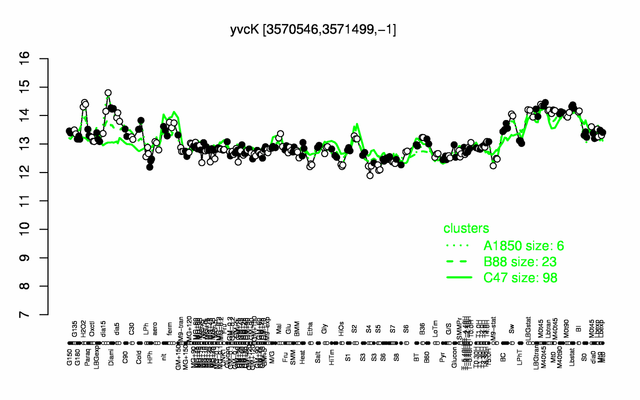Difference between revisions of "YvcK"
(→The gene) |
|||
| Line 50: | Line 50: | ||
===Phenotypes of a mutant === | ===Phenotypes of a mutant === | ||
| − | + | * unable to grow with gluconeogenic substrates as single carbon source {{PubMed|16272399}} | |
| − | + | * filamentous or L-shape-like aberrant morphologies (suppressed by Mg++) {{PubMed|16272399}}, this is supressed by overexpression of [[MreB]] or by deletion of ''[[ponA]]'' ([[ponA|PBP1]] ) {{PubMed|21320184}} | |
=== Database entries === | === Database entries === | ||
| Line 59: | Line 59: | ||
=== Additional information=== | === Additional information=== | ||
| − | |||
| − | |||
| − | |||
=The protein= | =The protein= | ||
Revision as of 19:47, 29 April 2013
- Description: essential for growth under gluconeogenetic conditions, required for correct localization of PBP1
| Gene name | yvcK |
| Synonyms | |
| Essential | no |
| Product | unknown |
| Function | localization of PBP1 |
| Gene expression levels in SubtiExpress: yvcK | |
| MW, pI | 34 kDa, 5.408 |
| Gene length, protein length | 951 bp, 317 aa |
| Immediate neighbours | yvcL, yvcJ |
| Get the DNA and protein sequences (Barbe et al., 2009) | |
Genetic context 
This image was kindly provided by SubtiList
| |
Expression at a glance PubMed
| |
Contents
Categories containing this gene/protein
carbon core metabolism, cell shape
This gene is a member of the following regulons
The gene
Basic information
- Locus tag: BSU34760
Phenotypes of a mutant
- unable to grow with gluconeogenic substrates as single carbon source PubMed
- filamentous or L-shape-like aberrant morphologies (suppressed by Mg++) PubMed, this is supressed by overexpression of MreB or by deletion of ponA (PBP1 ) PubMed
Database entries
- DBTBS entry: no entry
- SubtiList entry: [1]
Additional information
The protein
Basic information/ Evolution
- Catalyzed reaction/ biological activity:
- Protein family: UPF0052 family (according to Swiss-Prot)
- Paralogous protein(s):
Extended information on the protein
- Kinetic information:
- Domains:
- Modification:
- Cofactor(s):
- Effectors of protein activity:
- Localization: localized as a helical-like pattern PubMed
Database entries
- Structure:
- UniProt: O06974
- KEGG entry: [2]
- E.C. number:
Additional information
Expression and regulation
- Regulation: very weak stimuation of expression by citrate and succinate PubMed
- Regulatory mechanism:
- Additional information:
- translation is likely to require Efp due to the presence of several consecutive proline residues PubMed
Biological materials
- Mutant:
- Expression vector: pGP736 (N-terminal Strep-tag, purification from B. subtilis, for SPINE, in pGP380), available in Stülke lab
- lacZ fusion:
- GFP fusion:
- two-hybrid system: B. pertussis adenylate cyclase-based bacterial two hybrid system (BACTH), available in Görke lab
- Antibody:
Labs working on this gene/protein
Boris Görke, University of Göttingen, Germany Homepage
Anne Galinier, University of Marseille, France
Your additional remarks
References
Reviews
Original publications